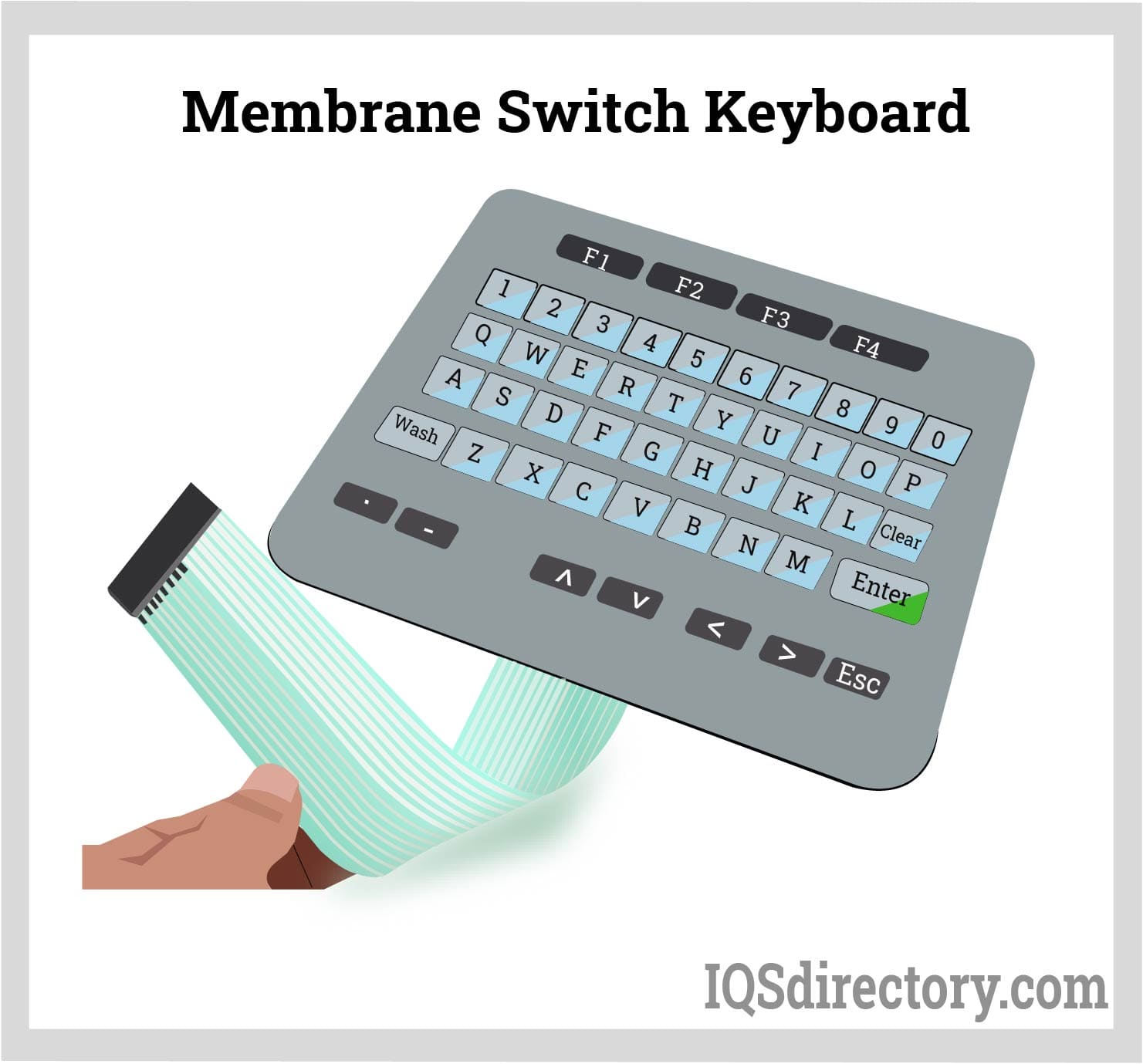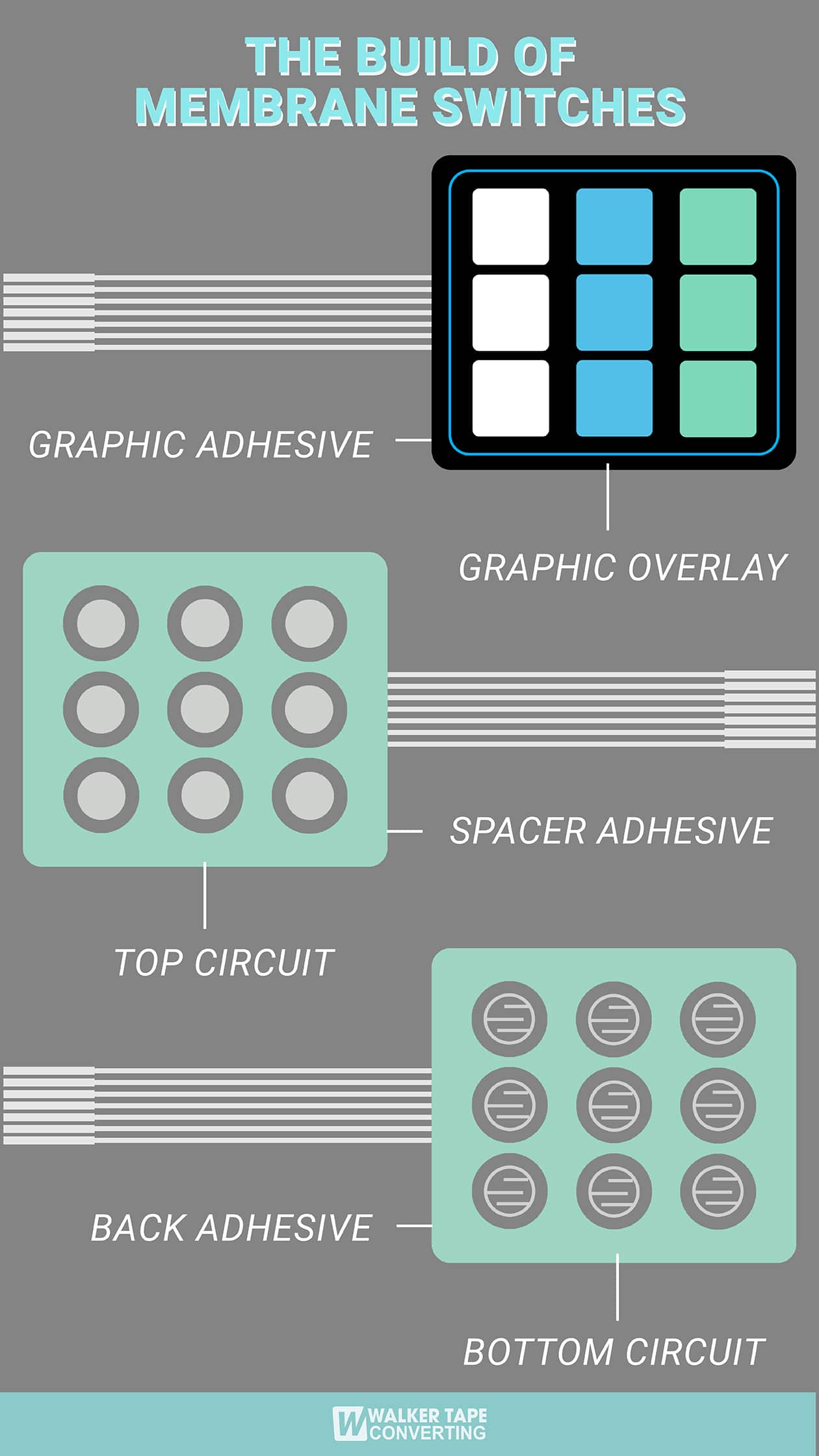Everything About Membrane layer Switch Over: A Comprehensive Guide for Beginners
Membrane layer buttons are crucial elements in modern electronics, supplying an unique interface for customer interaction - membrane switch. Their layered construction, consisting of overlays and conductive traces, supplies capability and toughness. Unlike traditional mechanical buttons, membrane layer switches offer a streamlined layout and personalized alternatives. Understanding their crucial features and advantages can transform item layout. Nonetheless, the complexities of their application and style factors to consider necessitate more exploration
What Is a Membrane Change?
A membrane layer button is a type of electric switch that includes a flexible membrane layered over a published circuit board. This style permits for a portable and streamlined interface, commonly used in different electronic gadgets. Membrane switches are commonly located in customer home appliances, medical equipment, and commercial machinery due to their toughness and resistance to environmental factors.The building normally includes multiple layers, such as visuals overlays and glue backing, which supply tactile comments and safeguard the wiring underneath. The operation of a membrane layer switch is initiated when pressure is applied to the surface, finishing an electric circuit.These buttons are valued for their flexibility, enabling personalized styles and printed graphics that accommodate details customer interfaces. Their low-profile nature reduces room demands, making them optimal for applications where traditional switches might not fit. On the whole, membrane switches offer a aesthetic and practical remedy for modern-day digital devices.
Secret Elements of Membrane Layer Changes
Membrane changes consist of a number of key components that add to their performance and performance. The top layer, called the overlay, supplies the interface and is typically published with icons or graphics. Under the overlay lies a spacer layer, which divides the conductive components and avoids unintentional activation. The following important component is the graphic layer, which boosts looks and guarantees the longevity of the design.Conductive traces, normally made from products like silver or carbon, are published on the circuit layer. When stress is used to the overlay, these traces enter contact, finishing the circuit. In addition, a support layer uses structural support and can be made from products such as polyester or polycarbonate. With each other, these elements create a trusted, straightforward interface ideal for different applications, from house home appliances to commercial devices. Understanding these elements is important for anybody thinking about membrane layer button innovation.
Exactly How Membrane Layer Changes Work
Recognizing just how membrane switches over feature is crucial for appreciating their prevalent usage in different tools. A membrane switch runs through a series of layers, including a visuals overlay, spacer, and a circuit layer. When pressure is put on the overlay, it compresses the spacer layer, enabling the circuit layer to make contact and finish an electric circuit. This activity sends a signal to the device, triggering a reaction, such as switching on a light or triggering a function.Membrane changes can be made with different features, including responsive feedback, backlighting, and personalized graphics, improving customer interaction. Their construction permits a covered layout, safeguarding the inner components from dirt, wetness, and contaminants. This sturdiness makes them suitable for diverse applications, from consumer electronics to commercial tools. Overall, the simplicity and efficiency of membrane layer switches over contribute to their popularity in modern technology.
Advantages of Membrane Switches Mechanical Switches
While mechanical buttons have actually long been a staple in numerous devices, membrane layer switches over deal unique benefits that make them significantly appealing. One considerable benefit is their slim profile, enabling even more compact designs and greater flexibility in item growth. In addition, membrane switches feature an uniform surface area, which improves visual allure and streamlines cleansing, making them ideal for environments where hygiene is critical.Another benefit is their resistance to dust and wetness. Unlike mechanical switches, which can be compromised by ecological aspects, membrane layer switches offer a closed user interface that shields against pollutants - membrane switch. Moreover, membrane layer buttons normally have a longer life-span because of fewer relocating parts, causing boosted resilience and reliability.Cost-effectiveness is also a notable advantage, as membrane switches can be generated in mass with lower manufacturing costs. These aspects combine to position membrane buttons as a practical option to standard mechanical choices in various applications
Typical Applications of Membrane Changes
Membrane buttons are widely used in numerous sectors, especially in consumer electronics and industrial control panels. In consumer gadgets, they provide a sleek, user-friendly user interface, while in commercial settings, they improve durability and capability. Recognizing these applications highlights the convenience and practicality of membrane layer buttons get more in modern-day technology.
Customer Electronics Devices
As consumer electronic devices remain to evolve, membrane switches have actually become a prominent choice for a selection of tools as a result of their convenience and smooth layout. These switches are commonly discovered in smartphones, tablet computers, and remote controls, where area is minimal and visual appeals matter. Their reduced profile and customizable layouts enable suppliers to produce user-friendly interfaces that boost the total customer experience. Furthermore, membrane layer switches are typically utilized in home appliances such as microwaves and coffee machine, giving instinctive control alternatives while find standing up to moisture and dust. The longevity and integrity of membrane switches over make them suitable for daily consumer items, making certain long life and constant efficiency. Generally, their combination in consumer electronic devices shows a blend of capability and modern-day design.
Industrial Control Panels
The applications of membrane changes extend past customer electronics, locating significant usage in industrial control panels. These buttons are favored for their resilience and resistance to extreme environments, making them optimal for producing and procedure control setups. They offer a reliable user interface for drivers to manage equipment, display procedures, and readjust setups. Membrane buttons can be tailored to match specific operational requirements, integrating attributes like backlighting and responsive responses, boosting customer experience. Their inconspicuous layout permits for combination into different equipment, while their capacity to endure spills, dust, and severe temperatures guarantees long life. In general, membrane buttons add to secure and reliable procedure in industrial applications, demonstrating their adaptability and effectiveness popular atmospheres.
Factors To Consider for Designing Membrane Layer Switches Over
When developing membrane layer buttons, picking the appropriate materials is vital to guarantee durability and capability. Additionally, recognizing layer configuration techniques can greatly impact the switch's efficiency and user experience. These considerations play a crucial function in producing reliable and efficient membrane layer switch designs.
Material Option Value
Material option plays an important function in the layout and performance of membrane switches. The selected materials straight influence the switch's durability, tactile feedback, and general visual. Key considerations include the substratum, which should supply structural stability while enabling adaptability, and the graphic overlay, which requires to be immune to use and environmental aspects. Conductive materials need to assure trustworthy electric performance, while adhesives must offer strong bonding without compromising the switch's procedure. Furthermore, compatibility with producing procedures and end-user settings is vital; products should withstand differing temperature levels, moisture levels, and chemical exposure. Inevitably, proper material option not only improves the membrane layer switch's efficiency yet likewise adds to its longevity and individual satisfaction, making it an essential element of the style procedure.

Layer Setup Strategies

Regularly Asked Questions
How Long Do Membrane Changes Generally Last?
Membrane layer buttons normally have a life expectancy of 1 to 5 million cycles, relying on usage and environmental conditions. Aspects such as design quality and operating frequency significantly influence their resilience and total performance longevity.

Can Membrane Changes Be Personalized for Particular Designs?
Membrane buttons can indeed be tailored to accommodate details designs, allowing for diverse shapes, colors, and performances. This adaptability makes it possible for makers to customize these switches to meet distinct visual and operational demands effectively.
What Products Are Made Use Of in Membrane Layer Switch Over Building And Construction?
Membrane layer switches are usually constructed making use of products such as polyester, polycarbonate, and adhesive layers. These products give resistance, toughness, and adaptability to environmental aspects, ensuring the switches work effectively in numerous applications and problems.
Are Membrane Switches Water Resistant or Immune to Dampness?
Membrane switches can be made to be moisture-resistant, making use of specialized materials and coatings. Their waterproof capacities depend on construction high quality and particular applications, making it crucial to assess demands for perfect performance in various settings.
Just How Are Membrane Changes Fixed if Harmed?
Fixing damaged membrane layer changes normally includes replacing the impacted layer or circuit. Specialists might additionally apply conductive sticky or make use of specialized repair work sets, making sure capability is restored without full replacement of the entire button setting up. Unlike typical mechanical buttons, membrane buttons provide a streamlined style and customizable alternatives. A membrane layer switch is a type of electrical switch that is composed of an adaptable membrane layered over a published circuit board. The procedure of a membrane layer button is started when stress is applied to the surface area, finishing an electrical circuit.These switches are valued for their adaptability, allowing customized designs and published graphics that cater to particular user interfaces. While mechanical buttons have long been a staple in numerous gadgets, membrane switches deal distinctive benefits that make them increasingly appealing. Membrane buttons generally have a longer lifespan due to fewer moving components, resulting in enhanced sturdiness and reliability.Cost-effectiveness is likewise a significant benefit, as membrane layer switches can be produced in mass with reduced manufacturing prices.